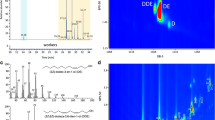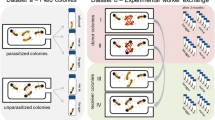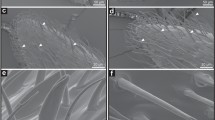Abstract
Ants of the genus Camponotus are able to discriminate recognition cues of colony members (nestmates) from recognition cues of workers of a different colony (non-nestmates) from a distance of 1 cm. Free moving, individual Camponotus floridanus workers encountered differently treated dummies on a T-bar and their behavior was recorded. Aggressive behavior was scored as mandibular threat towards dummies. Dummies were treated with hexane extracts of postpharyngeal glands (PPGs) from nestmates or non-nestmates which contain long-chain hydrocarbons in ratios comparable to what is found on the cuticle. The cuticular hydrocarbon profile bears cues which are essential for nestmate recognition. Although workers were prevented from antennating the dummies, they showed significantly less aggressive behavior towards dummies treated with nestmate PPG extracts than towards dummies treated with non-nestmate PPG extracts. In an additional experiment, we show that cis-9-tricosene, an alkene naturally not found in C. floridanus’ cuticular profile, is behaviorally active and can interfere with nestmate recognition when presented together with a nestmate PPG extract. Our study demonstrates for the first time that the complex multi-component recognition cues can be perceived and discriminated by ants at close range. We conclude that contact chemosensilla are not crucial for nestmate recognition since tactile interaction is not necessary.




Similar content being viewed by others
References
Akino T, Yamamura K, Wakamura S, Yamaoka R (2004) Direct behavioral evidence for hydrocarbons as nestmate recognition cues in Formica japonica (Hymenoptera: Formicidae). Appl Entomol Zool 39:381–387
Bagneres AG, Morgan ED (1991) The postpharyngeal glands and the cuticle of Formicidae contain the same characteristic hydrocarbons. Experientia 47:106–111
Bagneres AG, Billen J, Morgan ED (1991) Volatile secretion of dufour gland of workers of an army ant, Dorylus (Anomma) molestus. J Chem Ecol 17:1633–1639
Bhatkar A, Whitcomb WH (1970) Artificial diet for rearing various species of ants. Fla Entomol 53:229–232
Bonabeau E, Theraulaz G, Deneubourg JL, Franks NR, Rafelsberger O, Joly JL, Blanco S (1998) A model for the emergence of pillars, walls and royal chambers in termite nests. Philos Trans R Soc Lond B Biol Sci 353:1561–1576
Boulay R, Katzav-Gozansky T, Hefetz A, Lenoir A (2004) Odour convergence and tolerance between nestmates through trophallaxis and grooming in the ant Camponotus fellah (Dalla Torre). Insectes Soc 51:55–61
Buckner JS (1993) Cuticular polar lipids of insects. In: Stanley-Samuelson DW, Nelson DR (eds) Insect lipids. Chemistry, biochemistry and biology. University of Nebraska Press, Lincoln, Nebraska, pp 227–270
Buczkowski G, Kumar R, Suib SL, Silverman J (2005) Diet-related modification of cuticular hydrocarbon profiles of the Argentine ant, Linepithema humile, diminishes intercolony aggression. J Chem Ecol 31:829–843
Carlin NF, Hölldobler B (1986) The kin recognition system of carpenter ants (Camponotus spp.) I. Hierarchical cues in small colonies. Behav Ecol Sociobiol 19:123–134
Carlin NF, Hölldobler B (1987) The kin recognition system of carpenter ants (Camponotus spp.) II. Larger colonies. Behav Ecol Sociobiol 20:209–217
Carlin NF, Hölldobler B, Gladstein DS (1987) The kin recognition system of carpenter ants (Camponotus spp.) III. Within-colony discrimination. Behav Ecol Sociobiol 20:219–227
Cuvillier-Hot V, Renault V, Peeters C (2005) Rapid modification in the olfactory signal of ants following a change in reproductive status. Naturwissenschaften 92:73–77
D’Ettorre P, Heinze E, Schulz C, Francke W, Ayasse M (2004) Does she smell like a queen? Chemoreception of a cuticular hydrocarbon signal in the ant Pachycondyla inversa. J Exp Biol 207:1085–1091
Dietemann V, Peeters C, Liebig J, Thivet V, Hölldobler B (2003) Cuticular hydrocarbons mediate discrimination of reproductives and nonreproductives in the ant Myrmecia gulosa. Proc Natl Acad Sci USA 100:10341–10346
Endler A, Liebig J, Schmitt T, Parker JE, Jones GR, Schreier P, Hölldobler B (2004) Surface hydrocarbons of queen eggs regulate worker reproduction in a social insect. Proc Natl Acad Sci USA 101:2945–2950
Endler A, Liebig J, Hölldobler B (2006) Queen fertility, egg marking and colony size in the ant Camponotus floridanus. Behav Ecol Sociobiol 59:490–499
Franks NR, Deneubourg JL (1997) Self-organizing nest construction in ants: individual worker behaviour and the nest’s dynamics. Anim Behav 54:779–796
Gadau J, Heinze J, Hölldobler B, Schmid M (1996) Population and colony structure of the carpenter ant Camponotus floridanus. Mol Ecol 5:785–792
Greene MJ, Gordon DM (2003) Social insects—cuticular hydrocarbons inform task decisions. Nature 423:32–32
Hefetz A (2007) The evolution of hydrocarbon pheromone parsimony in ants (Hymenoptera: Formicidae)—interplay of colony odor uniformity and odor idiosyncrasy. A review. Myrmecological News 10:59–68
Heinze J, Stengl B, Sledge MF (2002) Worker rank, reproductive status and cuticular hydrocarbon signature in the ant, Pachycondyla cf. inversa. Behav Ecol Sociobiol 52:59–65
Hölldobler B, Michner CD (1980) Mechanism of identification and discrimination in social Hymenoptera. In: Markl H (ed) Evolution of social behavior. Verlag, Weinheim, pp 35–57
Hölldobler B, Wilson EO (1990) The ants. Belknap Press of Harvard University Press, Cambridge, Massachusetts, USA
Holm S (1979) A simple sequentially rejective multiple test procedure. Scand J Statist 6:65–70
Howard RW (1993) Cuticular hydrocarbons and chemical communication. In: Stanley-Samuelson DW, Nelson DR (eds) Insect lipids. Chemistry, biochemistry and biology. University of Nebraska Press, Lincoln, Nebraska, pp 179–226
Howard RW, Blomquist GJ (2005) Ecological, behavioral, and biochemical aspects of insect hydrocarbons. Annu Rev Entomol 50:371–393
Jutsum AR (1979) Interspecific aggression in leaf-cutting ants. Anim Behav 27:833–838
Kaib M, Eisermann B, Schoeters E, Billen J, Franke S, Francke W (2000) Task-related variation of postpharyngeal and cuticular hydrocarbon compositions in the ant Myrmicaria eumenoides. J Comp Physiol A Neuroethol Sens Neural Behav Physiol 186:939–948
Katzerke A, Neumann P, Pirk CWW, Bliss P, Moritz RFA (2006) Seasonal nestmate recognition in the ant Formica exsecta. Behav Ecol Sociobiol 61:143–150
Kleineidam CJ, Rössler W (2008) Adaptations of the olfactory system in social insects. In: Gadau J, Fewell J (eds) Organization of insect societies. Harvard University Press, Cambridge, MA (in press)
Lahav S, Soroker V, Hefetz A, Vander Meer RK (1999) Direct behavioral evidence for hydrocarbons as ant recognition discriminators. Naturwissenschaften 86:246–249
Leonhardt SD, Brandstaetter AS, Kleineidam CJ (2007) Reformation process of the neuronal template for nestmate-recognition cues in the carpenter ant Camponotus floridanus. J Comp Physiol A Neuroethol Sens Neural Behav Physiol 193:993–1000
Liebig J, Peeters C, Oldham NJ, Markstadter C, Hölldobler B (2000) Are variations in cuticular hydrocarbons of queens and workers a reliable signal of fertility in the ant Harpegnathos saltator. Proc Natl Acad Sci USA 97:4124–4131
Lockey KH (1988) Lipids of the insect cuticle—origin, composition and function. Comp Biochem Physiol B Biochem Mol Biol 89:595–645
Mann CA, Breed MD (1997) Olfaction in guard honey bee responses to non-nestmates. Ann Entomol Soc Am 90:844–847
Meskali M, Provost E, Bonavitacougourdan A, Clement JL (1995) Behavioral effects of an experimental change in the chemical signature of the ant Camponotus vagus (Scop). Insectes Soc 42:347–358
Morel L, Vandermeer RK, Lavine BK (1988) Ontogeny of nestmate recognition cues in the red carpenter ant (Camponotus floridanus)—behavioral and chemical evidence for the role of age and social experience. Behav Ecol Sociobiol 22:175–183
Nielsen J, Boomsma JJ, Oldham NJ, Petersen HC, Morgan ED (1999) Colony-level and season-specific variation in cuticular hydrocarbon profiles of individual workers in the ant Formica truncorum. Insectes Soc 46:58–65
Pricer JL (1908) The life history of the carpenter ant. Biol Bull 14:177–218
Ozaki M, Wada-Katsumata A, Fujikawa K, Iwasaki M, Yokohari F, Satoji Y, Nisimura T, Yamaoka R (2005) Ant nestmate and non-nestmate discrimination by a chemosensory sensillum. Science 309:311–314
Rice WR (1989) Analyzing tables of statistical tests. Evolution 43:223–225
Schmitt T, Herzner G, Weckerle B, Schreier P, Strohm E (2007) Volatiles of foraging honeybees Apis mellifera (Hymenoptera: Apidae) and their potential role as semiochemicals. Apidologie 38:164–170
Singer TL (1998) Roles of hydrocarbons in the recognition systems of insects. Am Zool 38:394–405
Soroker V, Vienne C, Hefetz A (1995) Hydrocarbon dynamics within and between nestmates in Cataglyphis niger (Hymenoptera, Formicidae). J Chem Ecol 21:365–378
Thomas ML, Parry LJ, Allan RA, Elgar MA (1999) Geographic affinity, cuticular hydrocarbons and colony recognition in the Australian meat ant Iridomyrmex purpureus. Naturwissenschaften 86:87–92
Vander Meer RK, Morel L (1998) Nestmate recognition in ants. In: Vander Meer RK, Breed MD, Espelie KE, Winston ML (eds) Pheromone communication in social insects: ants, wasps bees and termites. Westview, Boulder, Colorado, USA, pp 79–103
Wagner D, Brown MJF, Broun P, Cuevas W, Moses LE, Chao DL, Gordon DM (1998) Task-related differences in the cuticular hydrocarbon composition of harvester ants, Pogonomyrmex barbatus. J Chem Ecol 24:2021–2037
Wagner D, Tissot M, Cuevas W, Gordon DM (2000) Harvester ants utilize cuticular hydrocarbons in nestmate recognition. J Chem Ecol 26:2245–2257
Wagner D, Tissot M, Gordon D (2001) Task-related environment alters the cuticular hydrocarbon composition of harvester ants. J Chem Ecol 27:1805–1819
Wilson EO (1971) The insect societies. Belknap Press of Harvard University Press, Cambridge, Massachusetts, USA
Acknowledgments
This work was supported by the Deutsche Forschungsgemeinschaft, Bonn (SFB 554/A6). A.S.B. was supported by a grant from the German Excellence Initiative to the Graduate School of Life Sciences, University of Würzburg. We thank Ulrike Hartmann and Oliver Geissler for experimental support, and everyone in the department who randomized dummies for double-blind experiments. The performed experiments comply with the current laws of the Federal Republic of Germany.
Author information
Authors and Affiliations
Corresponding author
Rights and permissions
About this article
Cite this article
Brandstaetter, A.S., Endler, A. & Kleineidam, C.J. Nestmate recognition in ants is possible without tactile interaction. Naturwissenschaften 95, 601–608 (2008). https://doi.org/10.1007/s00114-008-0360-5
Received:
Revised:
Accepted:
Published:
Issue Date:
DOI: https://doi.org/10.1007/s00114-008-0360-5




